
37 minute read
The Fundamental
Keep up to date with legislation
Advertisement
By Owen Jones, senior consultant at JRP Solutions P erhaps the most significant piece of legislation enacted in the UK in recent times has been the UK Climate Change Act (2008), later amended in 2019. Under the act the Government signed up to a legally binding target to be net zero by 2050 based on 1990 levels, becoming the first G7 economy to do so.
Additionally, the EU Energy efficiency Directives (2012) also set a target to reduce energy consumption by 20 per cent through efficiency measures by 2020.
Another very significant piece of legislation is the UK Energy Act (2013) which is concerned with Brexit and the UK’s exit from the EU decarbonisation and reforming will also be addressed. the electricity markets particularly The Climate Change Act 2008 seeking security of supply as coalled to the setting up of the Climate fired power stations are taken Change Committee who are offline -an action that has driven responsible for national strategy and decarbonisation of the grid. reporting and measuring GHGs. The
Along with other EU member aim of this act was to introduce a states the UK signed the United package of policies and measures to Nations Committee on Climate transition to a low-carbon economy Change’s Paris Agreement and achieve targets. Measures are committing to carbon reduction delivered through either regulation targets. This has also driven policy and/or economic impact. Positive and the development of climate action towards decarbonising and change adaptation plans. efficiency either saves or generates
From these pieces of primary money, while negative action or poor legislation, a number of schemes performance in either goal incurs have been developed in the UK to additional cost. drive the following: Some notable measures that have • greenhouse gas (GHG) emissions now ended but may be relevant are: removal (all six listed in the Kyoto The Feed in Tariff scheme was a Protocol); government programme designed • increased renewable energy; to promote the uptake of renewable • increased energy efficiency; and low-carbon electricity generation • energy supply security; and technologies by giving a guaranteed • innovation and economic quarterly cash payment for kWh competitiveness in energy. generated. Although the scheme has
These five dimensions underpin now closed to new projects existing the myriad of schemes and participants will continue to receive programmes. This article will look payments which vary depending at some of the significant schemes on date of joining and renewable focusing on energy efficiency technology. measures relevant to public, Renewable Obligation commercial, manufacturing and Certificates (ROC) are certificates industrial property sectors that are issued to operators of larger the responsibility of the Business accredited renewable generating Energy and Industrial Strategy (BEIS) stations for the eligible renewable department. electricity generated. Operators
The additional complication of could then trade ROCs with other
parties. ROCs are ultimately used by electricity suppliers to demonstrate that they have met their obligations on renewable electricity. The scheme closed to new projects on 31 March 2017.
The Enhance Capital Allowance (ECA) scheme encouraged investment by allowing companies to write down investment in equipment on the approved Energy Technology List in the first year of operation. This scheme ceased on the 1st April 2020.
The revenue saved by closing the scheme will fund the Industrial Energy Transformation Fund.
The Carbon Reduction Commitment (CRC) scheme came to an end on the 1st April 2019 and is no longer part of the UK energy efficiency legislation landscape. CCL rates were increased significantly to compensate for the loss in tax revenue.
Mandatory GHG Reporting was a requirement of the Climate Change Act 2008. All ‘listed’ companies are required to report on their GHG emissions in the company’s directors’ report section of the annual report. Mandatory GHG reporting was introduced in 2013 to enact this requirement. The aims were to provide information for investors and improve disclosure of environmental performance.
This has now been superseded in most cases by the more comprehensive Streamlined Energy
Carbon Reporting (SECR) legislation. Some public bodies are not covered by SECR and are required to reporting GHG emissions under other legislation or commitments. Current schemes include:
The European Union Emissions Trading Scheme (EU ETS) scheme is mandatory if your business has more than 20MW thermal capacity of combustion plant installed at a site. Sites in the scheme are given a free allocation of carbon allowances with the total number of allowances capped. If the site emits more than its allowance further allowances can be purchased from the market. Unused allowances can either be sold or kept for future years. Emissions need to be reported annually. Hospitals and small emitters can enter a simplified opt out scheme where they are given an emissions target and must pay a penalty if they exceed this target.
Due to Brexit the UK will exit the EU ETS and the Government is setting up a new UK ETS from January 2021. The allowances allocated will be 5 per cent below the UK's proposed phase IV EU ETS allowances to give a more ambitious target. The proposed UK ETS cost for carbon will be based on a similar cap and trade system with a transitional Auction Reserve Price (ARP) of £15/ tonne CO2. There will also be a Cost Containment Mechanism (CCM) to manage spikes in the carbon price. It is the Government's intention to link the new UK ETS to the EU ETS and trade emissions between the two schemes, but this will depend on Brexit negotiations.
The Climate Change Levy (CCL) is an energy tax that is levied on all nondomestic energy users on electricity, natural gas, LPG/propane, other qualifying liquid and solid fuels if their monthly consumption is higher than a de minimis figure (1,000kWh for electricity or 4,397kWh for natural gas). The rates of CCL are charged as pence per kWh used, via supplier invoicing. The rate of CCL charged depends on the type of utility and changes annually as shown in Table 1.
T he Government’s Energy Saving Opportunity Scheme (ESOS) was developed as a response to article 8 of the EU Energy Efficiency Directive and obligates all large organisations which either employ 250 or more people, or have an annual turnover in excess of €50m and an annual balance sheet total in excess of €43m. An ESOS Assessment is required which calculates the total
Table 1: CCL Main Rates
Taxable commodity
Electricity (£ per kilowatt hour (KWh))
Gas (£ per KWh)
LPG (£ per kilogram (kg))
Any other taxable commodity (£ per kg)
energy use for an organisation for a chosen 12-month qualification period, identifies significant uses of energy, identifies energy saving opportunities, appoints an approved Lead Assessor and submits compliance to the Environment Agency. Records of the exercise must be kept and signed off at Director level. Compliance may also be demonstrated to the EA by having ISO 50001 accreditation that covers the whole organisation. A representative sample of at least 90 per cent of the organisation’s UK energy use must either be covered by ISO 50001, EPCs, Green Deal Assessments or compliant site energy audits. There is currently no requirement to implement any of the opportunities identified, however this may change in future years. Phase 2 of ESOS concluded on 5th Dec 2019 and the compliance cycle is repeated every four years. Site energy audits can be undertaken any time within the four years before the next compliance date.
Climate Change Agreements (CCA) were introduced in tandem with the CCL to assist high-energyusing companies in the UK maintain international competitiveness by offering reductions in CCL charges to firms that achieve emission reduction targets. CCA is a voluntary UK scheme which applies if a site or part of a site has an Integrated Pollution Prevention and Control (IPPC) permit or conducts one of the processes identified by the particular sector association. The benefit of being part of CCA is the reduction in CCL, which is applied to both electricity and gas
Rate from 1 April 2018
0.00583
0.00203
0.01304
0.01591
Rate from 1 April 2019
0.00847
0.00339
0.02175
0.02653
Rate from 1 April 2020
0.00811
0.00406
0.02175
0.03174
Rate from 1 April 2021
0.00775
0.00465
0.02175
0.03640
invoices, provided energy reduction targets specified in the agreement are met. For intensive energy users, having a CCA can reduce the CCL tax burden by hundreds of thousands of pounds a year.
A consultation was opened by the Government on the 16th April 2020 on the future of the CCA scheme. The primary aims of the consultation are to gain opinions on extending the current CCA scheme by two years, through the addition of a new Target Period 5, from 1 January 2021 to 31 December 2022 and extending certification for reduced rates of CCL for participants meeting obligations under the scheme to 31 March 2025 from 31 March 2023.
The consultation will also look to re-open the scheme to new entrants and applications are now being accepted with a deadline of 30th September 2020. However no final decision has yet been made. It is proposed for the new TP5 that the baseline for targets will be changed to 2018 from 2008, no banked surplus allowances will be carried over from TP4 and the buyout price will increase from £14/tCO2 to £18/ tCO2 for over target emission.
The Government is looking at the possibility of a further phase of CCAs but is likely to significantly alter the qualification criteria, scheme operation and incentive levels.
Carbon Price Support (CPS) is a measure introduced to support the EU ETS price for carbon emissions and encourage investment in low emission power generation in the UK by increasing the cost of electricity generation from fossil fuels. The CPS rates of CCL applies to electricity generation from fossil fuels where the installation has a generating capacity of 2.0MWe or more and is not good-quality CHP or standby generation. For export electricity generation, only the CPS rate is paid by the generating company on the fuel input and the main CCL rate for electricity is charged to the end user. For non-export generation both the CPS and main rates must be paid by the generating site.
Combined Heat and Power Quality Assurance (CHPQA) is a scheme relevant only to sites that have a combined heat and power engine installed. This is a voluntary scheme which rewards efficient, good-quality CHP by allowing participants to claim CCL exemption and allowed ECA claims when still available. Annual submissions are made to the CHPQA on the quantities of fuel used, electricity generated and heat used. From this data two parameters are calculated, the power efficiency and the quality index (QI). If the power efficiency is above a target, typically 20 per cent, and if the QI is above its target, typically above 100, then the CHP is deemed to be good quality and the CHP is exempt from all CCL payments on incoming fuel and electricity generated. If the power efficiency is below target, then a proportion of the CCL on the incoming fuel must be paid. If the QI is less than the target, then CCL must be paid on a proportion of the electricity generated and if over 2.0MWe some CPS will also need to be paid on the fuel input. To maintain accuracy
Table 2: CCL Discount for CCA Holders
Taxable commodity
Electricity
Gas
LPG
Any other taxable commodity
Rate from 1 April 2018
90%
65%
65%
65%
Rate from 1 April 2019
93%
78%
78%
78%
Rate from 1 April 2020
92%
81%
77%
81%
Rate from 1 April 2021
92%
83%
77%
83%
levels the associated metering must be regularly calibrated otherwise accuracy correction factors are applied to the meter outputs. The CHPQA will issue a certificate at the end of June each year confirming the performance of the installation in the previous year. Once the certificate is issued operators should reconcile the CCL payments for the previous year and reclaim/pay any over or under payments.
The Renewable Heat Incentive (RHI) encourages private households, communities, and businesses to install renewable energy technologies for heating purposes, through financial support.
There are two types of RHI schemes: domestic and nondomestic. The types of renewable heating systems are eligible for the non-domestic RHI scheme are solid biomass, heat pumps (air, ground and water sourced), geothermal, solar thermal and biogas.
Eligible installations receive quarterly payments over 20 years based on the amount of heat generated. Rates depend on the type, capacity and commissioning date of the installation.
However, the Government recently announced that it is set to replace the Renewable Heat Incentive with the Clean Heat Grant.
Last month it confirmed that the non-domestic RHI is to close to new applicants on 31 March 2021. However, the RHI for households is not going to close to new applicants until 31 March 2022.
The Clean Heat Grant replaces the RHI’s tariff-based support in favour of a £4,000 grant, set at a flat rate over scaling with system size or changing across technology types.
Funding for the Clean Heat Grant has been committed for two years to March 2024, after which the scheme will close to new applications.Energy Performance Certificates (EPC) are intended to inform potential buyers or tenants about the energy performance of a building, so they can consider energy efficiency as part of their investment or business decision. Only buildings with a floor area greater than 50m2 that is being sold or rented out or for a new construction qualify.
The certificate provides an energy rating of the building from A (Good) to G (Poor). The better the rating, the more energy efficient the building.
Display Energy Certificates (DEC) provide an energy rating of the building from A (Good) to G (Poor) are based on the actual amount of metered energy used by the building over the last 12 months. A DEC and advisory report are required for buildings with a total useful floor area over 250m2 that are occupied in whole or part by public authorities and frequently visited by the public and must renewed annually for larger buildings.
DECs must be displayed in a prominent place visible to the public and have a valid advisory report. This report contains recommendations for improving the energy performance of the building.
The Streamlined Energy and Carbon Reporting (SECR) framework came into effect in April 2019 and coincides with the closure of the CRC Energy Efficiency Scheme.
The legislation affects quoted companies, large unquoted companies and large limited liability partnerships (LLP) based on turnover, balance sheet and number of employees criteria, similar to ESOS. Businesses using less than 40MWh/year are exempt from reporting.
An annual director level report has to be compiled detailing energy use, carbon emissions, performance to targets, descriptions of actions taken and planned actions to reduce carbon emissions.
Energy use that must be covered in the required annual reporting is both scope 1 (primary fuels consumed directly, such as natural gas) and scope 2 (Imported energy such as electricity of heat) to include transport. Scope 3 emissions are not a requirement. Energy data and carbon emissions must be reported alongside a performance metric e.g. production per kWh and a high-level description of energy efficiency actions needs to be included in the annual report.
The Industrial Energy Transformation Fund (IETF) is intended to help businesses with high energy use to cut their energy bills and carbon emissions through investing in energy efficiency and low-carbon technologies. The fund has been under consultation, the results of which are due to be published soon. It is hoped the scheme builds on opportunities identified through ESOS and SECR and grants will be awarded to help fund both preliminary investigation and design work as well as purchasing and installation of equipment. The aim is to launch the first phase of the £315mi fund in summer 2020.
The Industrial Heat Recovery Support (IHRS) programme encourages and supports investment in heat recovery technologies. Businesses are helped to identify and invest in opportunities for recovering and reusing heat that would otherwise be wasted. The programme runs until March 2022.
Funding (from a total pot of £18m) is allocated through a competitive process. The next deadline for applying is 31 July 2020.
Industrial Strategy Clusters Mission focuses on industrial areas of high concentration of industrial activity. The six clusters with the largest carbon emissions in the UK are Humberside, south Wales, Grangemouth, Teesside, Merseyside and Southampton.
The Government’s mission is to establish the world’s first net-zero carbon industrial cluster by 2040 and at least one low-carbon cluster by 2030. The mission is backed by £170m public investment through the Industrial Strategy Challenge Fund.
Collaborations of organisations have been able to apply for grant funding, via Innovate UK, to help develop and implement
Table 3: CCL CPS Rates
Carbon Price Support rate commodity Gas
Unit
1 April 2015 to 31 March 2016
1 April 2016 to 31 March 2021 £ per kilowatt hour (kWh)
0.00334
0.00331
Petroleum gas or other gaseous hydrocarbon in a liquid state
£ per kilogram (kg)
0.05307
0.05280
Coal and other solid fossil fuels
£ per gigajoule (GJ) on gross calorific value (GCV)
1.56860
1.54790
decarbonisation of industrial clusters in the UK via either creating roadmap plans for industrial clusters or deployment of carbon reduction strategies and technology. The current application process is now closed. However, depending on the outcome of the phase 1 planning stage, further funding opportunities may become available.
All measures past and present including amendments are listed in the UK’S draft integrated National Energy and Climate Plan (NECP) which has been published by BEIS in the wake of Brexit.
An Energy White Paper is planned for publication this summer (2020) and is intended to set out a new approach to energy policy driving forward measures to reduce costs across the system through a greater role for markets, more agile and flexible regulation, a new framework for strategic intervention and a commitment to ensure system cost are distributed in a fair way.
Further reading • https://ec.europa.eu/energy/topics/energyefficiency/targets-directive-and-rules/energyefficiency-directive_en • http://www.legislation.gov.uk/ukpga/2008/27/ contents • http://www.legislation.gov.uk/ukpga/2016/20/ contents/enacted • https://www.gov.uk/government/collections/ energy-act • https://www.gov.uk/guidance/energy-savingsopportunity-scheme-esos • https://assets.publishing.service.gov.uk/ government/uploads/system/uploads/ attachment_data/file/803086/industrial-clustersmission-infographic-2019.pdf • https://apply-for-innovation-funding.service.gov. uk/competition/498/overview#summary • https://www.gov.uk/guidance/industrial-heatrecovery-support-programme-how-to-apply • https://www.ofgem.gov.uk/environmentalprogrammes/fit/about-fit-scheme • https://www.ofgem.gov.uk/environmentalprogrammes/non-domestic-rhi • https://www.gov.uk/government/collections/ energy-performance-certificates • https://www.gov.uk/government/publications/ display-energy-certificates-and-advisory-reportsfor-public-buildings • https://assets.publishing.service.gov.uk/ government/uploads/system/uploads/ attachment_data/file/585344/greeninggovernment-commitments-overview-reportingrequirements-2016-2020.pdf • https://www.gov.uk/guidance/industrial-energytransformation-fund • https://www.ofgem.gov.uk/system/files/ docs/2020/03/non-domestic_rhi_tariff_table_ q1_2020-21_corrected.xlsx • https://www.gov.uk/guidance/participating-inthe-eu-ets • https://www.gov.uk/government/publications/ climate-change-agreements-operations-manual--2 • https://www.gov.uk/government/publications/ environmental-reporting-guidelines-includingmandatory-greenhouse-gas-emissions-reportingguidance • https://www.gov.uk/government/publications/ uk-national-energy-and-climate-plan-necp
ENERGY EFFICIENCY LEGISLATION SPACE HEATING Please mark your answers below by placing a cross in the box. Don't forget that some Please mark your answers below by placing a cross in the box. Don't forget that some questions might have more than one correct answer. You may find it helpful to mark the answers in pencil first before filling in the final answers in ink. Once you have completed questions might have more than one correct answer. You may find it helpful to mark the answers in pencil first before filling in the final answers in ink. Once you have completed the answer sheet, return it to the address below. Photocopies are acceptable. the answer sheet, return it to the address below. Photocopies are acceptable.
QUESTIONS QUESTIONS
1) In 2019 the UK Government signed up 1. Which is the most common heating media in to a legally binding target to be net wet systems? zero by?
■ 2030 ■ 2040 ■ 2050 ■ 2060 ■ High temperature hot water ■ Steam 2) For ESOS, a representative sample of ■ Low temperature hot water
what percentage of the organisation’s energy consumption needs to be
■ Cold water
covered by assessments or ISO 50001?
■ 70% ■ 80% ■ 90% ■ 100% 2. What is the most common space heating
fuel in the UK?
3) How often is the ESOS reporting cycle ■ Fuel oil repeated? ■ Electricity ■ Every Year ■ Natural gas ■ 2 years ■ 4 years ■ Coal ■ 10 years
4) For ESOS how many of the identified opportunities must you implement?
■ None
3. What is a typical dry bulb space temperature for a home?
■ All ■ 160C ■ 50 per cent ■ 190C ■ Only those with a payback less than ■ 220C 3 years ■ 240C
5) What type of organisation may still need to undertake GHG reporting rather than comply with SECR? 4. What is currently the most common construction material for panel radiators?
■ Retail Outlets ■ Cast iron ■ Public bodies ■ Pressed steel ■ Hotels and Restaurants ■ Cast aluminium ■ Heavy industry ■ Copper
6) Why were CCL rates significantly increased on the 1st April 2019?
■ To offset lost revenue from closure of the CRC ■ To pay for more wind turbines
5. Which of these is a key component of a mechanical ventilation system?
■ A fan ■ An atrium ■ A chimney ■ Opening windows
■ To invest in energy efficiency in 3rd 6. Which is the ‘delivery end’ of a vapour world countries compression heat pump system? ■ To fund energy efficiency in industrial clusters ■ The evaporator ■ The condenser 7) Which of the following schemes is still ■ The compressor open to new applicants? ■ The slinky ■ FIT ■ ECA ■ ROC ■ RHI
8) What is the thermal capacity threshold for combustion plant at which a site needs to 7. Which of these factors is used by a weather compensation control system?
comply with EU ETS regulations? ■ Building thermal inertia ■ 2 MW ■ Time of day ■ 10 MW ■ Outside air temperature ■ 20 MW ■ Date ■ 20 kW
9) What is the de minimis for charging of CCL on electricity invoices? 8. Which of these factors is used by an optimum start control system?
■ 500 kWh ■ 1,000 kWh ■ 4,397 kWh ■ 10 MWh ■ Level of building occupancy ■ Outside air temperature ■ Boiler capacity ■ Boiler flow temperature
10) For DECs what two things must a qualifying building operator do? 9. Which types of space heating system can building management systems be used to control?
■ Display the certificate in a prominent location and have a valid advisory report ■ Any ■ Wet systems ■ Renew the certificate every six months and Display the certificate in a ■ Air handling plant ■ Boilers prominent location ■ Display the certificate in a prominent 10. What is a thermostat? location and renew the certificate every two years ■ Have a valid advisory report & Renew the certificate every two years ■ A temperature sensitive switch ■ A temperature sensor ■ A proportional control device ■ A digital display device
Please complete your details below in block capitals Please complete your details below in block capitals
Name ......................................................................................................................................................................... (Mr. Mrs, Ms) .................................... Name ......................................................................................................................................................................... (Mr. Mrs, Ms) ....................................
Business.................................................................................................................................................................................................................................... Business ....................................................................................................................................................................................................................................
Business Address ................................................................................................................................................................................................................. Business Address .................................................................................................................................................................................................................
.................................................................................................................................. Post Code .............................................................................................. .................................................................................................................................. Post Code ..............................................................................................
email address ......................................................................................................................................................................................................................... email address .........................................................................................................................................................................................................................
Tel No. ......................................................................................................................................................................................................................................... Tel No. .........................................................................................................................................................................................................................................
Completed answers should be mailed to: Completed answers should be mailed to: The Education Department, Energy in Buildings & Industry, P.O. Box The Education Department, Energy in Buildings & Industry, P.O. Box 825, GUILDFORD, GU4 8WQ. Or scan and e-mail to editor@eibi.co.uk. All 825, GUILDFORD, GU4 8WQ. Or scan and e-mail to editor@eibi.co.uk. All modules will then be supplied to the Energy Institute for marking modules will then be supplied to the Energy Institute for marking
How to obtain a CPD accreditation How to obtain a CPD accreditation from the Energy Institute from the Energy Institute
Energy in Buildings and Industry and the Energy Institute are delighted to Energy in Buildings and Industry and the Energy Institute are delighted to have teamed up to bring you this Continuing Professional Development have teamed up to bring you this Continuing Professional Development initiative. initiative.
This is the first module in the eighteenth series and focuses on Energy This is the ninth module in the seventeenth series and focuses on Space Efficiency Legislation. It is accompanied by a set of multiple-choice questions. Heating. It is accompanied by a set of multiple-choice questions.
To qualify for a CPD certificate readers must submit at least eight of the To qualify for a CPD certificate readers must submit at least eight of the ten sets of questions from this series of modules to EiBI for the Energy ten sets of questions from this series of modules to EiBI for the Energy Institute to mark. Anyone achieving at least eight out of ten correct answers on Institute to mark. Anyone achieving at least eight out of ten correct answers on eight separate articles qualifies for an Energy Institute CPD certificate. This can be eight separate articles qualifies for an Energy Institute CPD certificate. This can be obtained, on successful completion of the course and notification by the Energy obtained, on successful completion of the course and notification by the Energy Institute, free of charge for both Energy Institute members and non-members. Institute, free of charge for both Energy Institute members and non-members.
The articles, written by a qualified member of the Energy Institute, will appeal The articles, written by a qualified member of the Energy Institute, will appeal to those new to energy management and those with more experience of the to those new to energy management and those with more experience of the subject. subject.
Modules from the past 16 series can be obtained free of charge. Send Modules from the past 16 series can be obtained free of charge. Send your request to editor@eibi.co.uk. Alternatively, they can be downloaded your request to editor@eibi.co.uk. Alternatively, they can be downloaded from the EiBI website: www.eibi.co.uk from the EiBI website: www.eibi.co.uk
SERIES 17 SERIES 16 MAY 2019 - APR 2020 MAY 2018 - APR 2019 1 Batteries & Storage 1 BEMS 2 Energy as a Service 2 Refrigeration 3 Water Management 3 LED Technology 4 Demand Side Response 4 District Heating 5 Drives & Motors 5 Air Conditioning 6 Blockchain Technology 6 Behaviour Change 7 Compressed Air 7 Thermal Imaging 8 Energy Purchasing 8 Solar Thermal 9 Space Heating 9 Smart Buildings 10 Data Centre Management 10 Biomass Boilers
SERIES 18 SERIES 17 MAY / JUNE 2020 - MAY 2021 MAY 2019 - APR 2020 1 Energy Efficiency Legislation 1 Batteries & Storage 2 Building Controls* 2 Energy as a Service 3 Smart Grids* 3 Water Management 4 Lighting Technology* 4 Demand Side Response 5 Heat Pumps* 5 Drives & Motors 6 Metering & Monitoring* 6 Blockchain Technology 7 Air Conditioning* 7 Compressed Air 8 Boilers & Burners* 8 Energy Purchasing 9 Behaviour Change* 9 Space Heating 10 Combined Heat & Power* 10 Data Centre Management*
* ONLY available to download from the website after publication date * ONLY available to download from the website after publication date
Terms: in submitting your completed answers you are indicating consent to EiBI’s Terms: in submitting your completed answers you are indicating consent to EiBI’s holding and processing the personal data you have provided to us, in accordance holding and processing the personal data you have provided to us, in accordance with legal bases set out under data protection law. Further to this, EiBI will share with legal bases set out under data protection law. Further to this, EiBI will share your details with the Energy Institute (EI) with whom this CPD series is run in your details with the Energy Institute (EI) with whom this CPD series is run in contractual partnership. The EI will process your details for the purposes of marking contractual partnership. The EI will process your details for the purposes of marking your answers and issuing your CPD certificate. Your details will be kept securely at your answers and issuing your CPD certificate. Your details will be kept securely at all times and in a manner complaint with all relevant data protection laws. For full all times and in a manner complaint with all relevant data protection laws. For full details on the EI’s privacy policy please visit www.energyinst.org/privacy. details on the EI’s privacy policy please visit www.energyinst.org/privacy. • To hear more from the EI subscribe to our mailing list: visit https://myprofile. • To hear more from the EI subscribe to our mailing list: visit https://myprofile. energyinst.org/EmailPreferences/Subscribe energyinst.org/EmailPreferences/Subscribe


Energy in Universities
For further information on TROX UK visitwww.eibi.co.uk/enquiriesand enter ENQUIRY No. 127
Ian Thomas is product manager – Labcontrol, TROX UK
Under the microscope
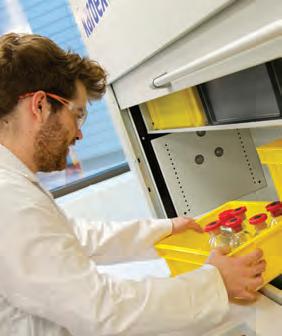
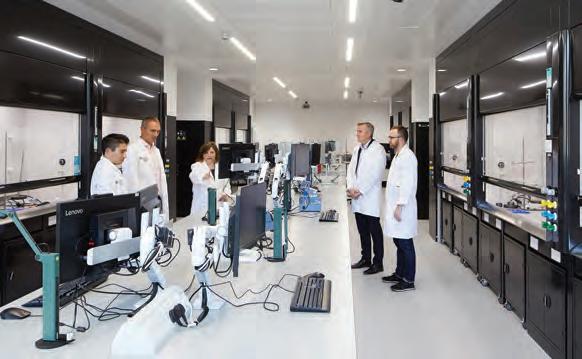
Ian Thomas examines how energy consumption contributes to the high cost of universities’ research facilities and how this might be mitigated S cientific research is the lifeblood of many universities, establishing international reputations, attracting students and securing funding. But these activities have high financial and environmental overheads. The energy consumption of university laboratories is often more than three or four times that of ordinary teaching spaces on a square metre basis. 1
The higher energy costs and carbon emissions of the science campus are typically associated with the air supply and extraction requirements of fume cupboards. Advanced air management technology is reducing energy use at the University of Birmingham When sashes of fume cupboards management system (such as the such as ventilated down flow tables, are open, the volumes of air TROX EASYLAB system) makes it canopy hoods or fume exhaust required to maintain a safe working possible for all input and extract air ‘snorkels’ can reduce energy environment for laboratory for the laboratory to be controlled consumption by taking away heat personnel increase significantly. For automatically to ensure that the at source, reducing loading on the example, a 900mm wide cupboard required ventilation strategy and site-wide cooling system. with a maximum sash height of levels of safety are maintained. With 6) Could the design of the air 500mm and face velocity of 0.5m/s this design approach, the supply and management system facilitate would extract approximately 225l/s extraction of the fume cupboards greater operational flexibility of the of conditioned air from the room. (or other technical air management laboratory spaces? A more flexible devices) is automatically balanced laboratory which enables multiple Energy reduction project and offset in line with changing scientific disciplines to work side-byWhen approaching an energy requirements, reducing the total side can be used by more students, reduction project for a university supply and extract volumes. For for more of the time, reducing there are a number of important example, if the fume cupboards expensive under-occupation of the questions that need to be asked: are open and extracting air, there facilities. 1) Are the fume cupboards fixed on a is not the same requirement for constant air volume, or is air volume the room system to carry out this Air management system variable? For example, extracting process. By scaling down room In the new Rosalind Franklin 225l/s of conditioned air from the exhaust air extraction in line with Science Building at the University of room the minimum air volume fume cupboard extraction, the Wolverhampton, a TROX EASYLAB could be around 55l/s with a variable room air management system is room air management system has air volume fume cupboard when the able to prevent wastage associated been installed to manage the supply sash is down. So converting from with over-supply of conditioned constant to variable volume could air, improving energy efficiency save 170l/s, when the sash is in the significantly. down position. 3) Could air change rates for the air 2) Would the site benefit from a conditioning systems on campus room air management system? be reduced (with the provision of Simply installing variable volume local overrides) at the weekend, or fume cupboards may not be overnight, when the laboratories are sufficient to achieve the ambitious unoccupied? sustainability targets of today’s 4) Could devices be installed to research-intensive institution. The close the sashes of fume cupboards ideal option is to fully integrate automatically when they are not in fume cupboard air supply and use by students? extraction with the wider air 5) Could energy consumption be management systems to prevent reduced by installing local cooling wastage. Installing a room air or extraction devices? Equipment and extract controllers for over 50 fume cupboards.
Responding rapidly to changes in extract volumes by the technical extraction devices, the room air management system offsets one form of exhaust air against another. This maintains the correct air flow balance and room pressure at all times in the laboratories, whilst generating energy savings by preventing over-supply and extraction of conditioned air. Auto-close mechanisms fitted to fume cupboards ensure that sashes close automatically, if left open unnecessarily.
At the University of Birmingham’s new Collaborative Teaching Laboratory (CTL) the installation of advanced air management technology is reducing energy consumption by maximising occupancy levels.
In one area of the CTL, for example, the TROX air management system, integrated with the site’s BMS, optimises energy efficiency of 50 fume cupboards. It divides the lab into five zones, each with ten fume cupboards, fitted with TROX EASYLAB TVLK-type fume cupboard controllers. Sash distance sensors control the volume flow rates based on the height of the sashes, and TROX BE-SEG-02 user displays, with traffic light warning systems and audible alarms, contribute to safe working procedures.
Each zone features two supply air VAV units which track the extract air, ensuring the maintenance of correct leakage flows. By matching the supply of air to the changing requirements of the space these features reduce over-supply and wastage of conditioned air, ensuring that multiple scientific disciplines can carry out teaching and research safely side-by-side. At the same time the optimum level of environmental and financial performance can be achieved. The resulting levels of efficiency have contributed to the building’s ‘Excellent’ BREEAM rating.
Reference 1) Peter James and Lisa Hopkinson, ‘Carbon, Energy and Environmental Issues Affecting Laboratories in Higher Education - A Supplement to the HEEPI Report on General Regulations and Schemes on the Topic’, August 2011.
eibi.co.uk/enquiries Enter 9
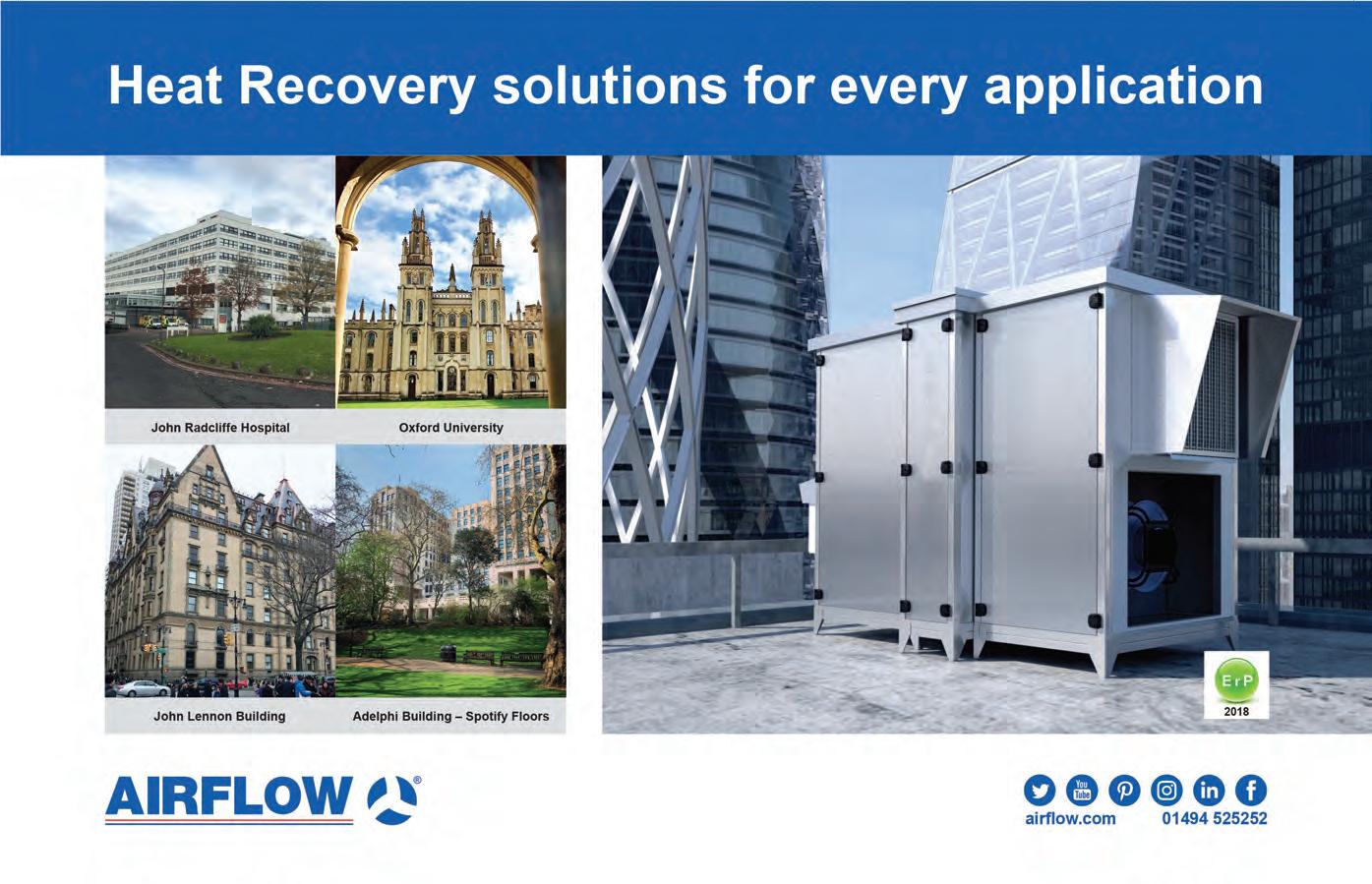

Heat Pump Technology
For further information on Low Carbon Farming visitwww.eibi.co.uk/enquiriesand enter ENQUIRY No. 129
Cultivating low carbon
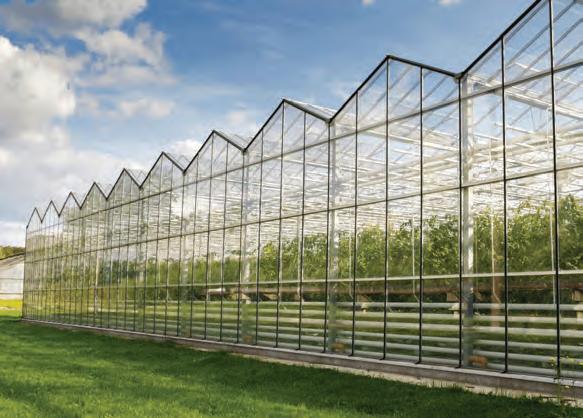

The innovative use of heat pumps will provide heating from waste water to cultivate tomatoes at one of the UK’s largest horticultural projects A world-first project to be completed later this year in East Anglia is using heat pumps to produce heat from waste water to cultivate tomatoes.
The two East Anglian projects are in Bury St Edmunds and Norwich. Both are owned by Greencoat Capital and developed by Brightonbased Low Carbon Farming Ltd. Together they have 29 hectares of indoor growing space.
Using heat pumps to capture waste heat from nearby water recycling centres, the projects displace traditional gas-fired greenhouse heating methods, and will increase significantly the Fruit of the vine: Low Carbon Farming plans to increase British tomato production by 12 per cent production of low carbon, British in our own challenge to become zero possible to strip the carbon out produce. carbon by 2030. Finding alternative of British growing and, with the
Electricity for the ground source sustainable uses for land close to appropriate policy environment heat pumps will be provided by water recycling centres which also in place, we look forward to the grid and combined heat and make use of excess energy makes considering the role we can play power units. These have the added sense for UK businesses.” in financing a wider roll-out of this benefits of providing waste heat solution.” which further supplements the Renewable heat ‘new frontier’ Low Carbon Farming has unveiled greenhouse heating and providing A fund managed by Greencoat its plans for a nationwide rollcarbon dioxide to enrich the Capital, the UK’s largest investor in out of sustainable infrastructure atmosphere inside the greenhouse renewable energy, acquired the two that could change the face of to encourage plant growth. East Anglian projects in September British horticulture. Buoyed by
The combined investment of 2019. James Samworth, partner the UK’s commitment to achieve £120m is expected to create 360 new at Greencoat Capital: “Renewable net zero emissions by 2050 and green economy jobs, rising to 480 in heat is a new frontier for UK climate the impending release of the high season. The greenhouse’s high action and every sector will need Government’s clean heat strategy, productivity, hydroponic growing to play its part. Our projects have the company has identified system will use 10x less water, demonstrated that it’s now perfectly potential sites for a further 41 giant, increase British tomato production by 12 per cent, and reduce the carbon emissions associated with doing so by 75 per cent. Even then, Britain is still expected to import more than 70 per cent of its tomatoes.
Anglian Water is working with Low Carbon Farming on the first projects to supply the waste heat and in doing so solve the environmental challenges associated with heating local water courses. David Riley, Head of Carbon Neutrality at Anglian Water: “These projects are helping us fulfil our environmental obligations and represent the kind of innovative approach to sustainability we are Heat pumps will capture waste heat from nearby water recycling centres to provide ideal growing conditions embracing right across our business low carbon greenhouses.
The plan represents a significant advance for national food resilience, capable of seeing the UK become self-sufficient in tomatoes and cucumbers, while removing the food miles associated with importing such produce. In practice, growing capacity is likely to be allocated to a wider range of produce, including peppers and flowers.
Nationwide roll-out Andy Allen, director of Low Carbon Farming, said: “Our East Anglian projects provide British farming with a bankable template for the nationwide roll-out of transformative, renewable heat solutions. Having secured the financing and proven the business model, and with the case for secure and sustainable British produce having been thrown into such sharp focus, it’s time to plan for the next stage.
“Policy decisions made the innovation behind our first projects possible – specifically, the entirely logical extension of the Tariff Guarantee until the end of the Renewable Heat Incentive in 2021. We now look to government for a clear and far-sighted decision to extend revenue support for renewable heating in British farming far beyond 2021.”
Through its tenancy agreements with third party growers, Low Carbon Farming’s East Anglian projects will supply low carbon, British tomatoes to retailers including Subway and Sainsbury’s.
Baroness Natalie Bennett of Manor Castle, former Leader of the Green Party and a long-time advocate of sustainable farming practice commented: “We need a proper food strategy in England (Wales and Scotland already have more or less decent ones). Our diets are deeply unhealthy and our farmers often face an unnecessary trade-off between the commercial and the environmental.
“British farming must increase its production of fruit and vegetables many times over but in a manner compatible with our net zero commitment. That’s why this wastebased innovation is so exciting: it smashes both boxes and establishes a highly replicable template for policy-makers to build upon.”

eibi.co.uk/enquiries Enter 11
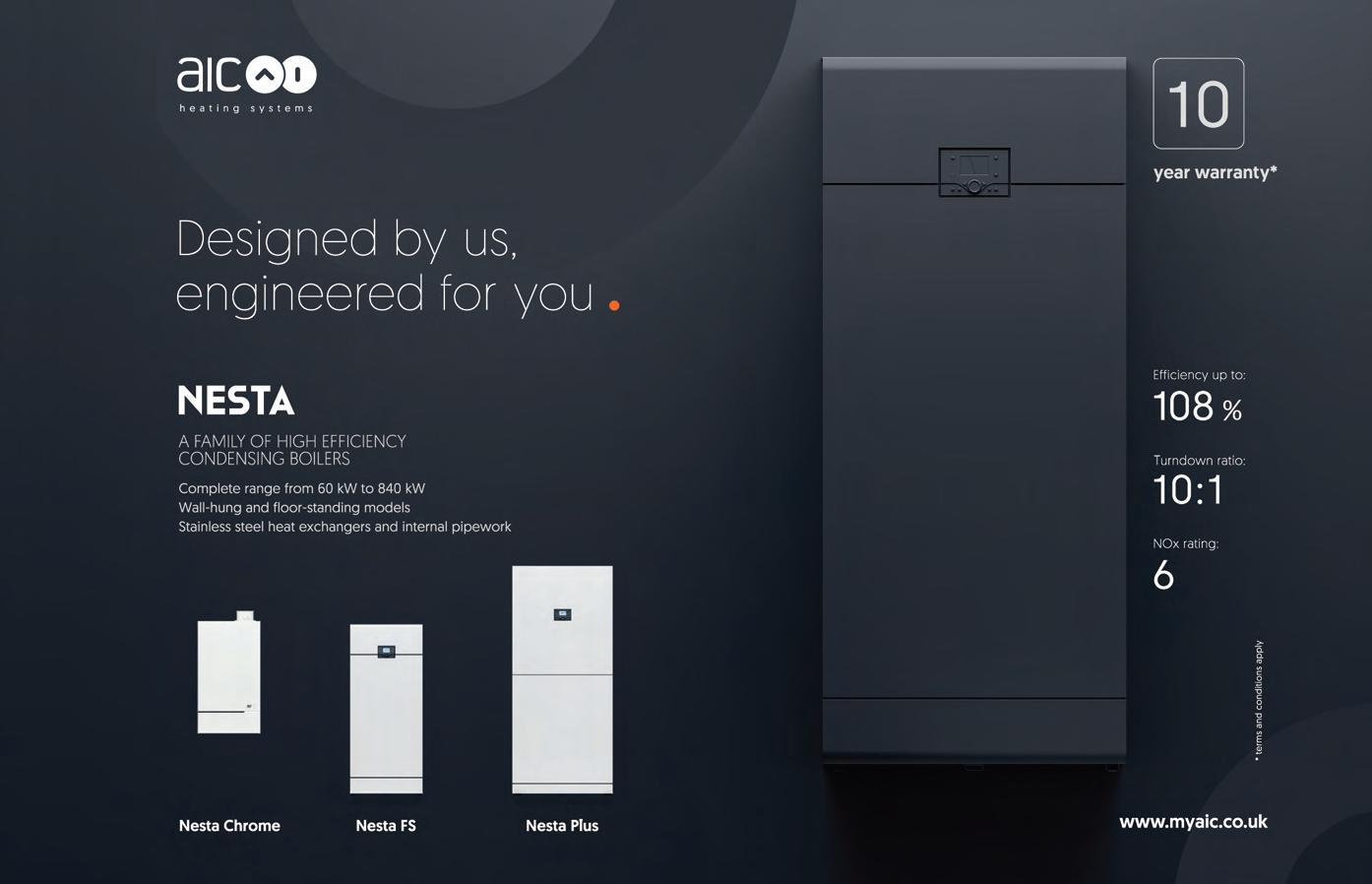
Heat Pump Technology
For further information on Stiebel Eltron UK visitwww.eibi.co.uk/enquiriesand enter ENQUIRY No. 130
Mark McManus is managing director at Stiebel Eltron UK
Keeping our heritage
Mark McManus discusses decarbonisation and the vital role retrofit heat pumps options could play in achieving the UK’s lofty targets I nstalling renewable options in new-build properties is among the Government’s primary focuses in At Welham Hall in North Yorkshire, a heat pumps system draws on a nearby lake as an energy source legislation designed to improve sustainability. The most recent of these – the Future Homes Standard 2025 – introduces new benchmarks requiring new-build homes to be future-proofed with low-carbon heating systems and also brings a focus on energy efficiency by 2025.
However, it’s key that this appetite to improve the green credentials of the country’s building stock extends beyond the new-build market.
The UK’s built environment currently contributes around 40 per cent of the country’s carbon footprint according to the UK Green Building tight or awkward spaces and a building’s listed status, this can be Council. Improving performance in efficient heat generation can offset a significant benefit. Allowing estates existing buildings is crucial if we are the lack of insulation often found teams and owners to preserve the to meet the increasingly challenging in older buildings. They can also be original radiators and other heating carbon reduction targets needed to supplemented by the fact that they systems within the restored building. meet global sustainability objectives. do not require additional structures Any efforts to decarbonise the UK to work, with existing outbuildings Renewable credentials economy must include a significant often being appropriate for housing The use of electricity to harvest focus on the retrofit market. the heat pump system itself. This energy from the environment means
Heat pumps offer the ideal flexibility is important given the that the renewable credentials of renewable solution to the issue of options for new external buildings to heat pumps surpass competing retrofit for hot water and heating – by house energy systems are limited in technology. Electricity is the only extracting heat from the air, ground heritage sites. energy source that can viably be or water to them repurpose and They can also integrate with generated by sustainable means, so generate renewable power. Thereby existing heating systems, creating as time passes and the continued providing clients with lower fuel bills hybrid options that allow for a decarbonisation of electricity and minimising their impact on the phased approach to energy efficiency. generation progresses, heat pumps environment with easy installation In an area where heritage heating will become an increasingly energy and minimal maintenance required. systems may require retention due to efficient and environmentally

Complicated endeavour Historic England estimates that there are around 500,000 listed buildings in the UK. Creating bespoke renewable energy systems like purpose-built structures for energy generation that require the adaptation of these building’s fabric is a complicated endeavour given the planning restrictions on heritage sites. However, the adaptability of heat pumps means that they are best placed to offer an option for those looking to revitalise a heritage building with minimal impact to the surrounding area.
They’re an effective solution too in that the correct heat pump specification can often work around
Welham Hall is a good example of how heritage sites need not be exempt from sustainable measures
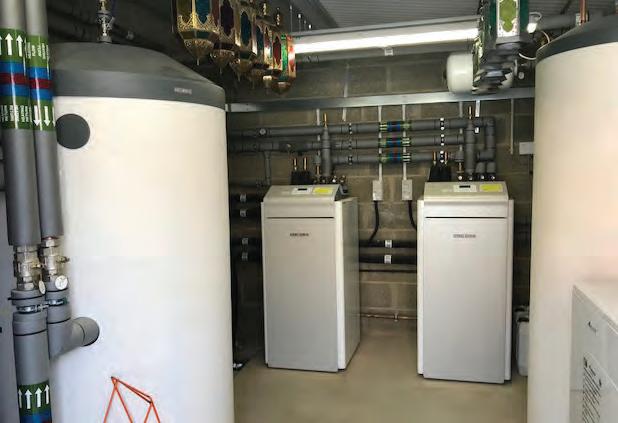
friendly option.
The retrofit of two ground-source heat pumps at Welham Hall, North Yorkshire as part of a wider restoration project offers a live demonstration of the potential that heat pumps hold as an option.
The system comprises two Stiebel Eltron WPF 13S heat pumps, which provide heating and hot water to the whole property using a nearby lake as a source. The lake supplies a consistent natural source of energy that can power the system with minimal impact on the environment, not only saving money but also improving the properties reputation for sustainable operation.
A core component of this restoration and retrofit was to minimise changes to the original buildings and visual impact on the wider estate. This prerequisite led to the design teams’ decision to use the existing lake as an energy source. It meant that trenches for a ground loop system, which would provide power to the system, were not required with the end results being a system that is near invisible.
While the heat pumps have so far provided a consistent performance in a range of weather conditions, a backup oil boiler was also installed as a fail-safe during particularly harsh temperatures. It ensures that the system can operate reliably in a range of situations with no loss in performance while vastly improving the sustainability of the site.
Since completion, the system has been monitored using an Internet Service Gateway, which has revealed a Seasonal Performance Coefficient of 3.36 – a key contributing factor to it receiving widespread industry recognition.
This project is a perfect example of how heritage sites need not be exempt from improved sustainability measures. Despite the challenges of listed status, potentially poor insulation and a lack of space, we have reached a point at which we can tastefully modernise these heritage building’s heating systems without compromising on performance.
Harnessing this technology and using it as part of a wider push to retrofit all heritage buildings, as well as homes and commercial buildings in the UK with renewable options will prove key in meeting our targets to reduce emissions.








